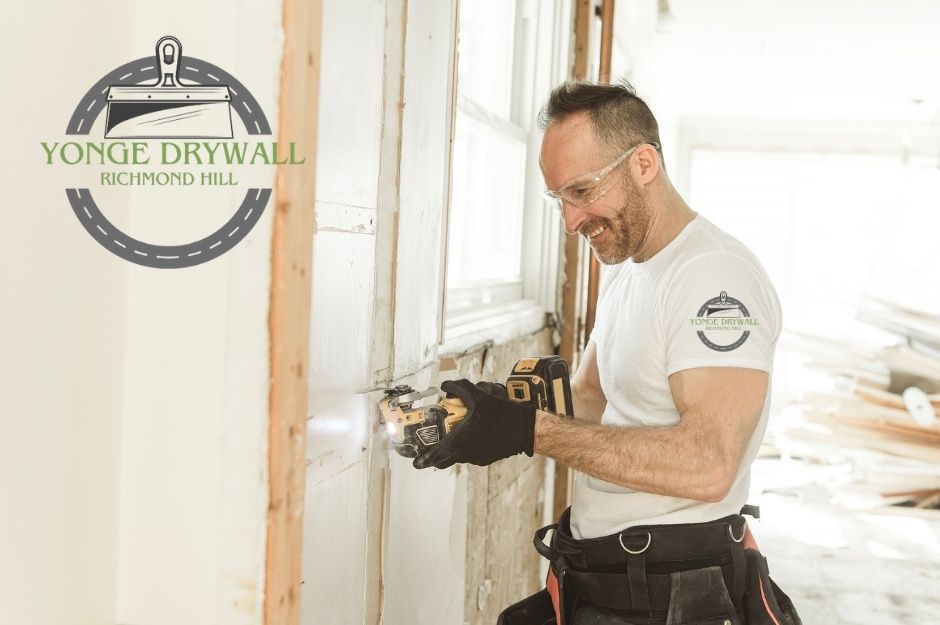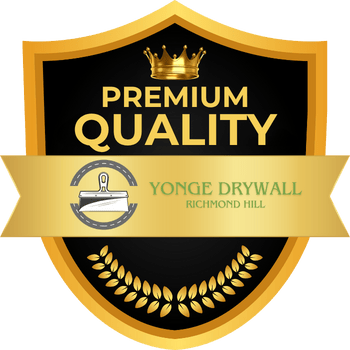Drywall Repair Brampton
Top-Quality Drywall Repair Service Company in Brampton, Ontario

Drywall problems can transform your home from comfortable to concerning in no time. Professional drywall repair contractors at Yonge Drywall Richmond Hill in Brampton, Ontario specialize in comprehensive solutions including ceiling crack repair, popcorn ceiling removal, hole patching, water damage restoration, and complete panel replacement.
Serving Brampton's population of 656,480 residents across 265.89 square kilometers, local contractors understand the specific challenges faced by homeowners in this rapidly growing Greater Toronto Area city.
Whether you're dealing with unsightly ceiling cracks, outdated popcorn textures, or holes from daily wear and tear, these issues require professional attention to restore your walls and ceilings to their original condition. These experts also handle specialized installations like soundproof drywall and provide finishing services such as texturing, mudding, and taping to ensure seamless results.
Your home's drywall serves as both a functional and aesthetic foundation for your interior spaces. When damage occurs, addressing it promptly prevents further deterioration and maintains your property's value while creating the smooth, polished surfaces you expect from quality construction. With Brampton's continental climate (Köppen Dfa classification) bringing temperature extremes from -31.3°C to 38.3°C, homes experience significant expansion and contraction that can stress drywall joints and seams over time.

Yonge Drywall Richmond Hill (HP)

Comprehensive Drywall Repair Services in Brampton
Professional drywall repair contractors in Brampton address structural damage from ceiling cracks and water infiltration to complete popcorn ceiling removal projects. These specialized services restore your home's interior surfaces to pristine condition. Whether you're in established neighborhoods like downtown Brampton near the historic Four Corners intersection at Main and Queen Streets, or in newer developments like Springdale and Bramalea, professional contractors serve all areas of the city.
Ceiling Crack Repair
Drywall cracks in your ceiling indicate underlying structural movement or settling issues that require immediate attention. Professional contractors assess the crack's severity to determine whether it stems from normal house settling or more serious foundation problems. In Brampton's clay-rich soil conditions common throughout the Region of Peel, seasonal moisture changes can cause foundation movement that manifests as ceiling cracks, particularly in older homes built before the city's 1974 amalgamation.
Common crack repair methods include:
- Mesh tape application for hairline cracks
- Fiberglass mesh for wider separations
- Joint compound filling and sanding
- Primer and paint matching
Water damage often accompanies ceiling cracks, particularly in bathrooms and kitchens. Contractors examine surrounding drywall for moisture penetration before beginning repairs. Brampton's average annual precipitation of 806.8mm, including significant snowfall averaging 114.5cm, can lead to ice dam formation and roof leaks that damage interior drywall, especially in areas bordering Caledon to the north along Mayfield Road.
The repair process involves cleaning loose debris, applying appropriate patching materials, and feathering edges for seamless integration. Multiple coats of joint compound ensure smooth surface preparation before final painting.
Popcorn Ceiling and Stucco Removal
Popcorn ceiling removal requires specialized techniques and safety protocols due to potential asbestos content in older installations. Professional contractors test materials before beginning removal work to ensure safe handling procedures. Homes built in Brampton during the 1960s and 1970s, particularly in the Bramalea planned community developed by Bramalea Limited, often feature popcorn ceilings that may contain asbestos and require certified removal.
The removal process involves plastic sheeting installation, spray application to soften texture, and careful scraping techniques.
Key safety considerations include:
- Asbestos testing for pre-1980 installations
- Dust containment systems
- Proper disposal methods
- Surface preparation for new finishes
Stucco ceiling removal follows similar protocols but requires different tools due to the harder texture composition. Contractors use power sanders and specialized scrapers to remove stubborn stucco without damaging underlying drywall.
Post-removal services include drywall repair, skim coating, and primer application. Many homeowners choose smooth ceiling finishes or modern texture applications after popcorn removal. This upgrade is particularly popular in Brampton's historic downtown area near the Heritage Theatre site and Gage Park, where homeowners are renovating century-old properties while maintaining architectural character.
Replacing Damaged Ceiling Panels
Extensive water damage or structural issues often necessitate complete drywall panel replacement rather than simple patching. Contractors remove damaged sections and install new drywall sheets with proper fastening techniques.
Panel replacement involves:
- Precise measurements and cutting
- Stud location and secure fastening
- Joint taping and mudding
- Texture matching and painting
Sagging drywall panels require immediate replacement to prevent collapse and further damage. Professional assessment determines whether additional structural support is necessary before installing new panels. In multi-generational homes common throughout Brampton's diverse South Asian community (44.3% of the population as of 2016), basement ceiling renovations for secondary suites require code-compliant drywall installation meeting Regional Municipality of Peel building standards.
Contractors match existing ceiling height and ensure proper insulation placement during replacement work. Quality installations include appropriate screw spacing and joint treatment for long-lasting results.
Wall Hole Patching and Restoration
Drywall holes from accidents, door handles, or mounting hardware require different repair approaches based on size and location. Small holes under two inches typically use mesh patches, while larger damage needs backing board support.
Professional drywall patching ensures invisible repairs through proper technique and materials. Contractors cut clean edges around damaged areas and install appropriately sized patches with secure backing.
Hole repair process includes:
- Damage assessment and preparation
- Backing installation for larger holes
- Patch cutting and placement
- Multiple compound coats
- Sanding and texture matching
Complex wall damage may require partial stud replacement or additional framing support. Experienced contractors identify structural concerns and address underlying issues during restoration work. With Brampton Transit providing extensive bus service throughout the city's 265.89 square kilometers—including the Züm rapid transit system along major corridors like Main/Hurontario Streets—contractors can efficiently serve properties from Mount Pleasant Village in the north to areas bordering Mississauga along Steeles Avenue in the south.
Water-damaged drywall requires complete removal and replacement rather than surface patching to prevent mold growth and structural weakness.
Drywall Installation Solutions
Professional drywall installation requires precision techniques and quality materials to ensure long-lasting results. Specialized installations like soundproofing and both residential and commercial projects demand specific expertise from experienced contractors.
Soundproof Drywall Installation
Soundproof drywall installation involves using specialized materials and techniques to reduce noise transmission between rooms. Mass-loaded vinyl and acoustic drywall panels create effective sound barriers in your home or office. In densely populated areas like Bramalea City Centre and downtown Brampton near the busy CN Intermodal Yards east of Airport Road, soundproofing has become increasingly important for residents dealing with rail traffic and urban noise.
The installation process includes adding resilient channels between studs and drywall sheets. These metal channels decouple the drywall from the frame structure, preventing sound vibrations from traveling through walls.
Double-layer drywall systems provide enhanced soundproofing capabilities. The first layer uses standard drywall, while the second layer incorporates acoustic dampening compounds between sheets. This is particularly valuable for properties near Highway 410, which runs north-south through the middle of Brampton, and Highway 407 along the southern boundary, where traffic noise can be significant.
Professional contractors seal all gaps and joints with acoustic caulk to prevent sound leaks. Proper sealing around electrical outlets, light switches, and baseboards ensures maximum noise reduction performance.
Residential and Commercial Installations
Residential drywall installation focuses on creating smooth, finished surfaces for homes. Standard ½-inch drywall works well for most interior walls, while ⅝-inch panels provide better fire resistance and sound control.
Commercial installations require different specifications and materials. Fire-rated drywall meets building code requirements for office buildings, retail spaces, and industrial facilities. Major commercial projects in Brampton include work at facilities like the Bramalea Civic Centre building (which housed Chinguacousy Township offices and is being converted to a medical school opening in 2025), the Peel Regional Police headquarters, and numerous business locations throughout the city's thriving commercial districts.
Moisture-resistant drywall works best in bathrooms, kitchens, and basement applications. These specialized panels prevent mold growth and structural damage in high-humidity environments. Given Brampton's average relative humidity of 60% and the region's clay soil conditions that can contribute to basement moisture issues, moisture-resistant materials are essential for below-grade installations.
Installation techniques vary between project types. Residential work emphasizes aesthetic finish quality, while commercial projects prioritize code compliance and structural integrity.
Experienced drywall repair contractors handle both installation types efficiently. They understand local building codes and use proper fastening patterns for each application. All work must comply with Regional Municipality of Peel building standards and Ontario Building Code requirements administered through Brampton City Hall at Main Street downtown.
Expert Drywall Finishing Techniques
Professional drywall finishing transforms rough installations into smooth, paint-ready surfaces through precise mudding and taping methods. Texture matching ensures seamless repairs that blend with existing wall surfaces.
Drywall Mudding and Taping
Proper mudding creates smooth transitions between drywall panels and conceals seams permanently. You need three coats of joint compound applied in progressively wider passes.
The first coat embeds paper tape into fresh compound along seams. Apply compound with a 6-inch knife, pressing tape firmly to eliminate air bubbles.
Your second coat extends 2-3 inches beyond the first application. Use an 8-inch knife to feather edges and build up recessed areas around screw heads.
Final Coat Application:
- 10-12 inch knife for smooth finish
- Extend 2-3 inches past second coat
- Light pressure to avoid tool marks
- Sand lightly between coats if needed
Corner beads require similar three-coat treatment. Apply compound evenly on both sides, feathering away from the metal edge.
Drywall cracks need mesh tape or paper tape depending on crack size. Small stress cracks work well with mesh, while larger separations require paper tape for strength. Temperature fluctuations in Brampton—where record lows reach -31.3°C in winter and highs reach 38.3°C in summer—create expansion and contraction cycles that can stress improperly finished joints, making quality taping techniques essential for long-term durability.
Texture Matching and Application
Matching existing textures requires identifying the original application method and recreating the pattern precisely. Common residential textures include orange peel, knockdown, and smooth finishes.
Orange peel texture uses diluted joint compound sprayed through a hopper gun. Adjust air pressure and compound consistency until spray pattern matches surrounding areas.
Knockdown texture starts with orange peel application, then uses a trowel to flatten raised areas. Timing matters - wait until compound loses its wet sheen before knocking down.
Texture Tools:
- Hopper gun for spray applications
- Plastic trowel for knockdown
- Brushes for stipple patterns
- Rollers for subtle textures
Drywall patching areas need texture applied after compound fully cures. Prime patched areas before texturing to ensure uniform absorption and appearance. Historic homes in neighborhoods like Churchville and Huttonville—two communities that maintained their identities after Brampton's 1974 amalgamation—often feature unique plaster textures that require specialized matching techniques to maintain period authenticity.
Practice texture techniques on scrap drywall first. Small variations in pressure, timing, or compound consistency create noticeably different results.
Repairing Water Damage and Sagging Drywall
Water damage creates structural weakness in drywall materials, while sagging occurs when ceiling panels lose their support or mounting strength. Both issues require immediate attention to prevent further deterioration and potential safety hazards. Brampton's location in the Greater Toronto Area, with Toronto Pearson International Airport located just 10.55 kilometers east in Mississauga at an elevation of 173.4 meters, means the city experiences weather patterns that can lead to ice dams, roof leaks, and moisture infiltration requiring prompt professional attention.
Addressing Sagging Ceilings
Sagging drywall typically results from inadequate fastening, moisture exposure, or structural settling. You'll notice visible drooping or separation along seams where panels meet.
Common causes include:
- Insufficient screws or nails during installation
- Weakened ceiling joists
- Heavy insulation weight
- Previous water exposure
Drywall repair contractors assess the extent of sagging before determining repair methods. Minor sagging requires additional fasteners placed every 6-8 inches along joists. Severe cases need complete panel replacement. In older properties constructed during Brampton's rapid growth periods—when the town expanded from 1,800 residents in 1869 to becoming Ontario's ninth most populous municipality with 656,480 people by 2021—building standards may have been less stringent, making professional assessment particularly important.
The repair process involves removing loose sections and installing new drywall with proper spacing. Contractors ensure adequate support by checking joist integrity and adding blocking where necessary.
Mitigating and Repairing Water Damage
Water-damaged drywall becomes soft, discolored, and structurally compromised. You must address the moisture source before beginning any ceiling repair work.
Signs of water damage:
- Brown or yellow staining
- Soft or crumbling texture
- Visible mold growth
- Musty odors
Damaged sections require complete removal and replacement. Contractors cut out affected areas extending 6 inches beyond visible damage to ensure complete removal of compromised material. Professional drywall companies serving Brampton understand that the city's average annual snowfall of 114.5cm and 44.7 snowy days per year can lead to ice dam formation, particularly on homes in areas like Snelgrove (which extends slightly north of Mayfield Road along the Caledon border) where exposure to harsh winter conditions is greatest.
New drywall installation includes moisture barriers and proper sealing. The replacement process involves measuring, cutting, securing, and finishing with appropriate joint compound and texture matching. All water damage repairs should be documented for insurance purposes and reported to the Peel Regional Public Health Department if mold is present, as required by regional health standards.
